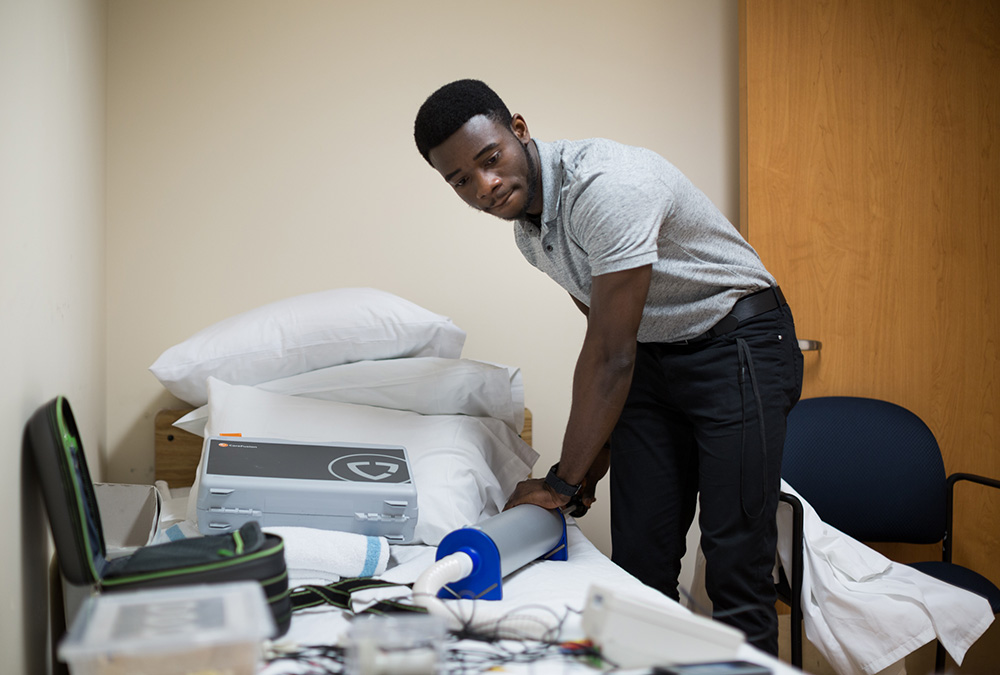Fields of Study

Our fields of study are designed with this key aim in mind: innovation through specialization. Expertise is incredibly valuable in industry today, and by focusing your talents and efforts toward your passions, our program will prepare you for solving the most pressing problems in electrical and computer engineering, and making your own research breakthroughs. We’ll give you the tools, facilities, mentors and access to industry opportunities you need. The ideas and vision are yours.

“Toronto Metropolitan University's engineering programs allow each student to find a niche that’s enjoyable and fulfilling. In biomedical engineering, I work at the leading-edge of exciting advances and go where no one has gone before.”
Karl Magtibay
Biomedical Engineering, BEng ’12, Electrical Engineering, MASc ’14, PhD Candidate
Five Fields of Study to Choose From
Where electrical and computer engineering meet anatomy and physiology, biomedical engineering is the interdisciplinary study of technology in health care. Exploring human-computer interaction, telemedicine, biomedical signal analysis, bioinformatics, medical instrumentation and computer vision, research within this field leads to new and innovative breakthroughs in pathology, diagnosis, treatment and rehabilitation. Through our state-of-the-art labs and facilities, faculty and students partner with leading clinicians from Sunnybrook Hospital and St. Michael’s Hospital’s Institute for Biomedical Engineering, Science and Technology (iBEST), making the most impact on patient care.
Research Areas:
- 3D printing
- Artificial neural networks
- Bioinformatics, signal modelling and analysis
- Biomechanics, prosthetic devices and assistive technologies
- Biomedical implants, textile computing and wearable technology
- Integrated biomedical sensors and transducers
- Machine vision image-guided surgery
- Medical imaging, image analytics and machine learning
- Medical robotics and image-guided surgery and therapy
- Musculoskeletal biomechanics and mechanobiology
- Tissue engineering and regenerative medicine
Research Laboratories and Facilities:
- Biomedical Signal and Image Processing Lab (BSIPL)
- Biophotonics and Bioengineering Laboratory
- Image Analysis in Medicine Lab (IAMLAB)
- Image Guided Therapy Lab
- Maternal Fetal Imaging (MFI) Lab
- Optimization Problems Research and Applications Laboratory (OPR-AL)
Information is everywhere – how it gets transmitted is where technology comes into play. In the era of the Internet of Things (IoT), communications research is tasked with staying ahead of the technological curve. Encompassing digital signal processing, mobile and wireless communications, optical communications and computer communications, research in this field helps autonomous vehicles avoid collision, increases data storage and computing power via cloud computing, and improves functionality of digital communications through 5G networking.
Research Areas:
- 5G networking and the Internet of Things (IoT)
- Analog-to-digital data converters and mixed-mode circuits and systems for passive wireless microsystems
- Cognitive radio systems and dynamic spectrum management
- Intelligent antenna and radio systems
- Microwave engineering
- Network architecture, design, optimization and security
- Optical communications and visible light communications
- Radio resource management
- Wireless communications
- Wireless positioning sensor networking
Research Laboratories and Facilities:
- Communications and Signal Processing Applications Laboratory (CASPAL)
- Microwaves and Antennas Laboratory (MA-Lab)
- Optimization Problems Research and Applications Laboratory (OPR-AL)
- TMU Communication Lab
- Wireless Networking and Communication Research (WINCORE) Lab (external link)
Merging engineering with computer science, this field focuses on the integration of hardware and software systems. Advancing the capabilities of computer systems, our researchers apply their work to fields including robotics, artificial intelligence, aerospace, multimedia and manufacturing. Subfields include distributed software systems, embedded systems, computer vision, reconfigurable computers, memory architectures and field-programmable gate array (FPGA) design, as well as micro-electromechanical system (MEMS) circuits, analog and digital integrated circuits, mixed-mode circuits and very large-scale integration (VLSI) circuits for optical and wireless communications.
Research Areas:
- Computer architecture and hardware
- Distributed systems and cloud computing
- Fault tolerance and security
- Heterogeneous computing
- Parallel computing
- Reconfigurable and adaptive computer systems
- Software engineering, coding and computer programming
- System-on-chip design and synthesis
Research Laboratories and Facilities:
- Embedded Reconfigurable Systems Laboratory
- Optimization Problems Research and Applications Laboratory (OPR-AL)
- Microsystems Research Laboratory (MSRLab)
- Laboratory for Systems, Software and Semantics (LS3)
This field of engineering applies automatic controls to the design, implementation and integration of electric drives and energy systems. Power and control systems research is leading the charge against climate change through renewables, smart loads and energy storage technologies. Modernizing the build and management of electricity delivery systems means distributors are better equipped to detect and restore outages and to integrate more renewables, and users can manage electricity consumption more efficiently.
Research Areas:
- Advanced manufacturing and robotics
- Control of robotics manipulators
- Electrical and renewable energy systems
- Electricity generation, transmission and storage
- Electromagnetics
- Embedded control systems
- Linear and nonlinear programming
- Power electronics and medium-voltage drives
- Power system stability, security and protection
- Cyber-physical security of smart grids
- Wireless power transmission
- Electric vehicle charging technology
- High-power converters and AC drives
- Predictive control of energy conversion systems
Research Laboratories and Facilities:
- Laboratory for Electric Drive Applications and Research (LEDAR)
- NSERC Energy Storage Technology Network
- Schneider Electric Smart Grid Laboratory
Whether it’s a noise you hear, an image you see or an electromagnetic wave that’s invisible to the naked eye, signals are all around us. Exploring communication systems, digital signal processing, mobile and wireless communication systems, and telemedicine, signal processing and multimedia is at the heart of some of the most prevalent topics in technology today – from big data to augmented reality to machine learning.
Research Areas:
- Audio and multimedia signal processing
- Augmented and virtual reality
- Big data analytics, management and data science
- Computer vision and modelling
- Data denoising and compression
- Information retrieval and semantic technologies
- Language and sensory perception
- Machine learning and artificial intelligence
- Multimedia content analysis
- Statistical signal processing
Research Laboratories and Facilities:
- Communications and Signal Processing Applications Laboratory (CASPAL)
- Computer Vision and Image Processing Laboratory (CVIP)
- Dependable Adaptive Systems Group (DAS)
- TMU Multimedia Research Laboratory
- Signal Analysis Research Group